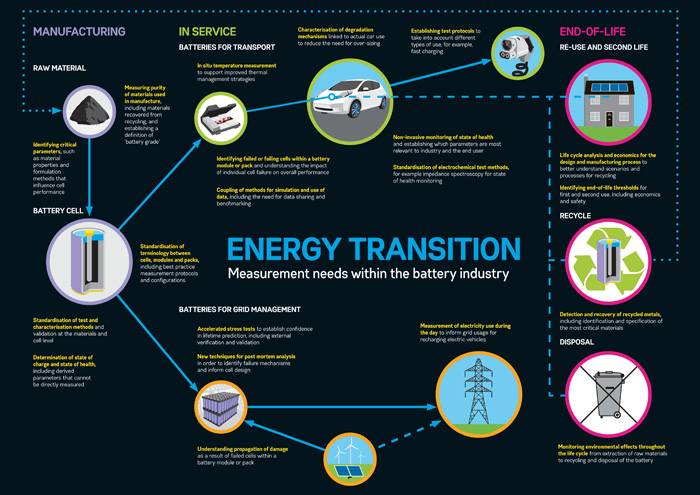Sustainable use of energy is one of the greatest challenges facing the world today. A major transition from fossil fuels to renewable energy is under way in most developed countries, driven by the need to cut greenhouse gas emissions and mitigate air pollution in urban areas.
According to the Royal College of Physicians, in the UK alone there are around 40,000 premature deaths annually as a result of air quality related illnesses. In addition to this, the transport sector accounts for more than 20% of the UK's greenhouse gas emissions.
NPL is leading the way in addressing these challenges by developing the measurement infrastructure to support the development and commercialisation of high energy density batteries for use in the energy sector.
Batteries have provided an easy and efficient means of storing energy for over 200 years. Following the introduction of lithium ion batteries, we have seen the energy density of batteries increase significantly over the past few decades, enabling a revolution in portable electronics (smartphones and laptops) and electric vehicles (EV).
Battery development is not only relevant for our infrastructure now, but for our future too. Energy storage has been highlighted as a major priority in both the UK Industrial Strategy, and the UK Measurement Strategy – with a recent government announcement outlining plans to ban the sale of petrol and diesel cars by 2040.
The report also discusses the potential for large-scale, storage applications for batteries, specifically the role of Li-ion batteries, in addressing the challenges of decarbonising the transport sector and balancing the grid through storage.
Dr Gareth Hinds, NPL Fellow and Science Area Leader in Electrochemistry, said:
"Batteries have an important role to play in the UK's future energy infrastructure. However, we need to ensure that they remain safe and sustainable throughout their life cycle.
"The report provides industry professionals with an outline of the key measurement challenges affecting the growth of battery development, both in the UK and across the globe. Advances in these areas will ensure that high energy density batteries have the capacity and longevity needed now, and for years to come."

Click to open
In consultation with industry, academia and government, NPL has identified the five high-priority measurement issues that need to be addressed, to pave the way for an electric future:
- Ensuring quality control throughout the manufacturing process by developing cost effective screening tools and establishing acceptable tolerance limits to ensure the performance and lifetime of the module or pack is optimised;
- Developing diagnostic techniques to monitor state of health and identify failed or failing cells within a battery module or pack, in order to better understand and mitigate critical degradation mechanisms;
- Developing predictive models for battery performance and lifetime using both data-driven and fundamental approaches, to reduce development costs and facilitate design optimisation;
- Identifying end-of-life thresholds for second life and recycling, including assessment of the commercial viability of processes for re-use and recycling, and
- Establishing standards for state estimation to generate more reliable and comparable data and ensure safe operation.
These are cross-sector measurement challenges that relate to any high energy density battery application, whether that be for stationary power, transport or portable devices. Tackling these challenges will require both the right expertise and a harmonised effort from funding bodies, industry, research institutes, standardisation bodies and policymakers.
Find out more about NPL's work on batteries
Contact: the Environment team
05 Dec 2017
pdf
Download